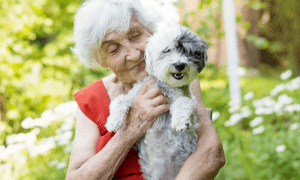“This post contains affiliate links, and I will be compensated if you make a purchase after clicking on my links.”
Many people associate a dog muzzle with an aggressive dog and think that the only reason to use one is to prevent the animal from causing harm to people, but there are many other reasons for them. While they are used for training and behavioral challenges, they are excellent for a range of purposes.
Reasons for dogs to wear a muzzle include:
- Preventing them from digesting things that could upset their stomachs when out walking
- Preventing them from eating the feces of other animals when out walking
- Avoiding them posing a risk to wildlife – even if they are only being playful!
- Controlling their response to anxiety around the close proximity of other dogs or strangers
- Keeping your dog and the vet safe during veterinary procedures.
Visiting the vets can be scary for your dog, especially if they are in pain. It can be difficult for them to understand what is happening to them, and they may feel threatened. Some pups resort to snapping, growling and even biting – not because they are aggressive by nature, but because they are trying to show the vet that they feel worried, uncomfortable or scared.
These are the reasons why it is best to use a muzzle on every dog, and to dispel the myth that a muzzle automatically means a trouble pup.
Remember, with a properly fitting basket muzzle, your dog can still breathe easily, pant, bark, drink, and take treats.
How to train your dog to wear a muzzle
It’s common for dogs to reject wearing a muzzle initially. It can be a strange feeling for them and may even make them more anxious, especially when going to the vets.
This is why it is a great idea to allow plenty of time to train your dog to happily wear a muzzle. Each dog will take to the process differently. Some will progress through the steps with ease, over a few days of 3 – 4 brief training sessions per day. For others, it will be necessary to repeat some or all of the steps several times before continuing onto the next.
By following this step-by-step guide to muzzle training, you will make wearing a muzzle a much more acceptable experience for them and thus produce lasting results.
1. Gently introduce the muzzle
If your dog seems worried by its mere presence, or if you’ve tried unsuccessfully to use one with them before, The Vets give the advice to not to put it on them just yet. They say, “Instead, simply place it on the floor and encourage them to touch or sniff it.
Every time they do, reward them with praise and a yummy treat. Don’t force them to touch it, though. Once they are happily touching and sniffing the muzzle and then looking to you for a reward, you can move onto step two.”
2. Encourage further interaction
Place a yummy treat, like a piece of sausage or cheese, into the muzzle and let your pup put their nose inside it and take the treat straight back out. Don’t attempt to close the muzzle yet – we are still working on positively conditioning their association to it. When your dog is used to putting their nose in it, you can start using an action call name such as ‘muzzle on.’
3. Hold the muzzle on without fastening it
When your dog puts their nose in to retrieve the treat, say ‘muzzle on’ and then hold it on with the straps behind their head for just a couple of seconds. Then release it and let them take their nose out.
Repeating this action gets them comfortable with having the muzzle on without the immediate anxiety of it being out of their control. Talking to them and telling them that they are being good as you do this can help them to relax further.
4. Fasten the muzzle around their neck
This time, work on familiarising them with the clasp of the muzzle being fastened around their neck, without having it over their nose. Some dogs are uncomfortable with the clasp itself, and the noise of it fastening, so it’s best to train them to relax when they hear it before proceeding further.
5. Briefly fasten the muzzle
Repeating step 3 but instead, fasten the muzzle whilst their nose is in it – and then undo it straight away and let them take their nose out. Rushing this step will only undo all of the positive conditioning you have worked on.
6. Gradually increase the time it’s fastened
Slowly but surely, increase the amount of time that they spend in the fastened muzzle. Remember to still always put treats inside the muzzle before your dog puts their nose in, and talk to them, telling them how well they are doing. You can also try to feed them a tasty treat while they are wearing the muzzle.
If your dog seems uneasy, take a break and then start over from the previous step – you may have just been moving a little too quickly. The key is to not force any of the steps and condition them to only feeling positive emotions whilst getting them used to wearing their muzzle. Muzzles are an effective way of keeping both your dog and anyone they come into contact with safe, no matter your dog’s temperament!
About the Author: Emma is a professional writer and blogger, with two furry friends and a lot of pet behavioral and pet health knowledge to share. She has written for numerous big animal magazines and health sites, and is a regular contributor to The Catington Post.


















